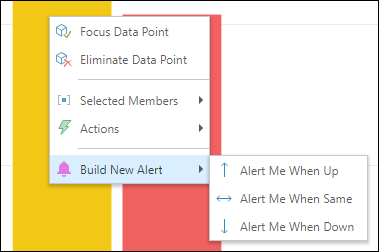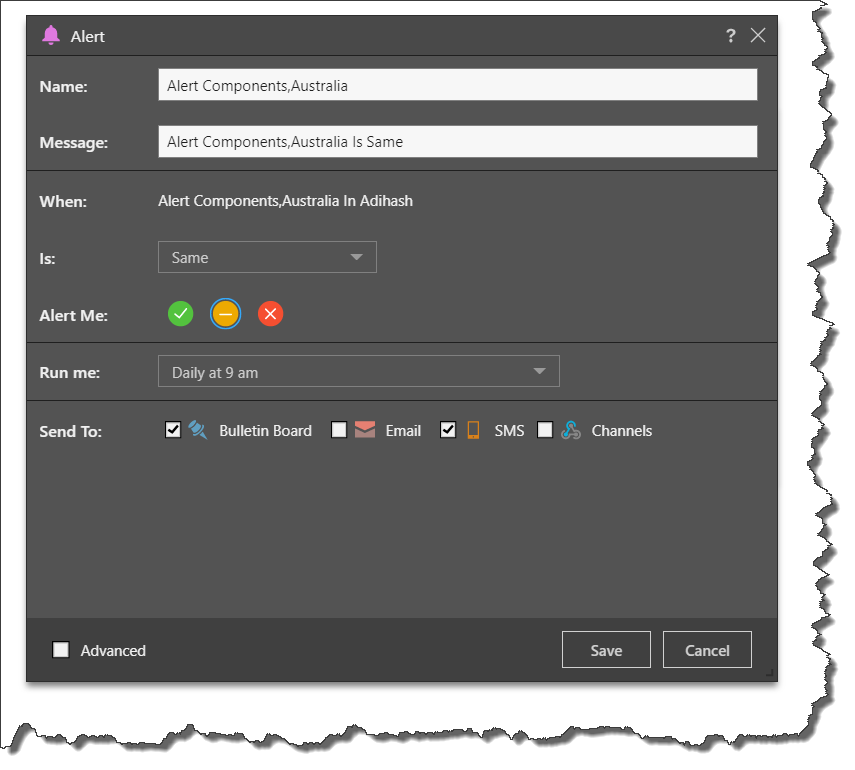Users can build alerts based on given cells within a visual. You will then receive alerts based on the triggers you've defined. For instance, you may set an alert to be triggered if the costs for a given product increase. Depending on your requirements, you can build a basic alert, or an advanced alert.
Tip: Alerts can be configured in Discover (click here for details of Smart Alerts and Advanced Alerts) and in Present at runtime.
This feature is only available with Enterprise licensing.
The following video demonstrates Alerts:
Building an Alert
Before you begin
Alerts can only be configured for saved discoveries, so start by saving your visual. If your visual includes unsaved changes, the Build New Alert option will be disabled on the right-click menu.
Building your Alert
- Right-click the relevant data point (that is, a grid cell, a chart column, and so on) to open the context menu.
- From the context menu, open the Build New Alert sub-menu and choose your required alert type:
- Alert Me When Up: To get an alert when the value of the given data point is up.
- Alert Me When Same: To get an alert when the value of the given data point is the same.
- Alert Me When Down: To get an alert when the value of the given data point is down.
- Use Smart Alert: To set up an alert that uses machine learning to identify values that fall dramatically outside of an expected range and triggers an alert to the user.
- Configure the alert from the Alert Builder dialog (continue reading to learn how).
Tip: To build an alert for multiple cells in the query, you can use the selection or lasso tool to select the relevant cells, and then right-click the selection to open the context menu.

Once inside the alert dialog, there are more choices for triggering a data alert.
You can see information about alerts from the Bulletin Board and the Alerts Feed.
Alert Builder dialog
Open the context menu on the relevant data points and make a selection from the Build New Alert sub-menu to open the Alert Builder dialog:

- Name: Name your alert; by default, it is named according to the members in the given data point.
- When: Displays the given data point that the alert will be triggered for.
- Is: Select an Alert Trigger from this drop-down. It provides a simple way to set up the alert logic trigger based on your selected data points. See below for more.
- Outcome Status: Choose the outcome that should be displayed in the alert based on the value (see below).
- Run me: Select a time when the alert should run. The basic alert builder enables scheduling of the alert job based on a number of presets. If you want to create your own schedule, configure an advanced alert.
- On Demand: Use on demand scheduling to trigger the alert schedule to run when the underlying data model is reprocessed. You must also configure on demand subscriptions for the relevant data models via the Master Flow or APIs.
- Send to: Choose where you want to receive the alerts; either Bulletin Board, email, SMS, or channel Webhook. Note that email and SMS can only be selected if messaging is enabled from the Admin console. The basic alert builder allows you to have alerts sent to yourself only. If you want to distribute the alert to other users, configure an advanced alert.
- Advanced: Select this option to configure an advanced alert (not available with the Community Edition).
Alert Triggers
The alert triggers can be set to a number of "simple" choices. The simple choices either specify the direction of change to alert on, or specify alert when there is movement by an amount or against a value. For example, the following indicates that the alert should be triggered when the value is up by 25%:

The simple choices include:
- Up - A simple increase from the last measured value
- Down - A simple decrease from the last measured value
- Same - No change from the last measured value
- Up by amount - A specified increase from the last measured value
- Down by amount - A specified decrease from the last measured value
- Greater than - Greater than a specified value
- Less than - Less than a specified value
- Greater than or equal - Greater than or equal to a specified value
- Less than or equal - Less than or equal to a specified value
- Does not equal - Is not equal to a specified value
- Automatic Detection - This runs the Smart Alerts engine. For more information, see Smart Alerts in Discover.
Note: You can HEAVILY configure and adjust these options using the advanced alert setup.
Alert Outcomes
The user can elect what type of alert outcome icon is shown when the alert runs. The icon outcome does not itself indicate if the alert is successful or not. For example, an alert that measures things that produce "good news", may have the green outcome icon - so when the user gets the message, they see "good" news. Likewise, an alert that is triggered when there is "bad news", would use the red icon.
Smart Alerts
The Smart Alerts engine monitors a selected data point over time, updating each time data is refreshed or according to the alert’s scheduled frequency. Historical values are analyzed using time series machine learning algorithms to generate a forecast of expected future values. If new data points fall significantly outside the defined tolerance range, the system triggers an alert, notifying the user of a potential anomaly.
- Click here to learn more about Smart Alerting
Smart Alerts are licensed separately.
Managing Alerts
Once an alert has been created, it can be managed from the Content Manager through the related content item's Action Panel. Note that the Content Manager's Actions panel differs slightly for Pro and Analyst clients.
Related information
Data Source Authentication
If you’re using Windows Authentication or SAP Logon Tickets to connect to your data source, you may be prompted to enter Authentication credentials when saving your changes.
- Click here to learn more about Data Source Authentication.